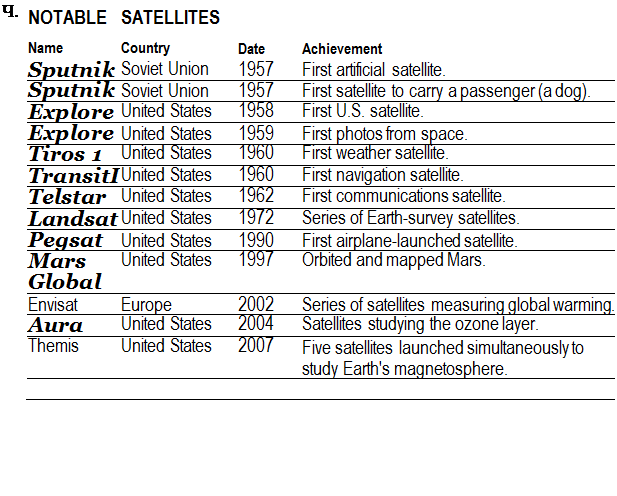Satellite Orbits
A satellite’s orbit depends on the task for which it is designed. Most satellites are launched in the same direction as Earth is spinning, and this is called a prograde orbit. To launch in the opposite direction, like throwing a ball into the wind, requires more booster power and fuel.
О A polar-orbiting satellite is prepared for launch in 2000. The satellite joined the polar – orbiting operational environmental satellite (POES) program, which provides data about the global climate and weather.
Scientists choose various orbits for their satellites, depending on the location of the launch site and the task of the satellite. Orbits fall into three types: high geostationary orbit, Sun – synchronous polar orbit, and low orbit.
A high geostationary orbit keeps a satellite always in the same position with respect to Earth. The satellite makes one orbit in the same period of time as Earth makes one rotation (23 hours, 56 minutes, 4.09 seconds). To do this, it must orbit at a height of about 22,300 miles (about 35,900 kilometers) above Earth’s surface. By orbiting in tandem with Earth, the satellite appears stationary, or synchronous (in time), with respect to the rotation of the planet.
A Sun-synchronous polar-orbiting satellite travels above the North and South poles. It flies at a height of about 540 miles (about 870 kilometers) and passes the Equator and each of Earth’s latitudes at the same time each day. Being Sun-synchronous means the satellite passes overhead at the same solar time through the year, so it can transmit data (on weather, for example) at consistent times. Its data can be compared year by year.
Low-orbiting satellites fly at a height of 200-300 miles (320-485 kilometers). A low orbit requires the least rocket
 |
power and is often chosen for observatory satellites, such as the Hubble Telescope. Hubble orbits Earth at a height of about 375 miles (600 kilometers), making one orbit every 97 minutes.
Some orbits are circular, while others are elliptical (egg-shaped). The length of time a satellite takes to make one orbit is called its orbital period.
A satellite’s initial velocity is high enough to counter the force of gravity and keep it in orbit, but friction (from Earth’s atmosphere and from the Sun’s energy) gradually slows the satellite’s speed. Its orbit begins to decay. Eventually, as the satellite descends into the thicker layers of the atmosphere, it burns up or breaks up.
Military Satellites
Military satellites include spy or reconnaissance satellites. These satellites are fitted with scanning devices and cameras that can detect objects on the ground. Some of these objects may be as small as a truck hundreds of miles below the spacecraft. Spy satellites also can detect missiles being fired. The first military satellite able to detect missile launches was Midas 2, launched by the United States in 1960. Early spy satellites took photographs on film that were returned to Earth in small capsules that landed by parachute. Modern spy satellites are equipped with digital imaging systems, and they relay their images directly from space.
A number of countries have military satellites. Military navigation satellites are used by aircraft, submarines, surface ships, and land vehicles. Anti-satellite weapons, known as “killer” or “suicide” satellites, are designed to track, locate, and destroy other satellites or orbital weapons systems.










